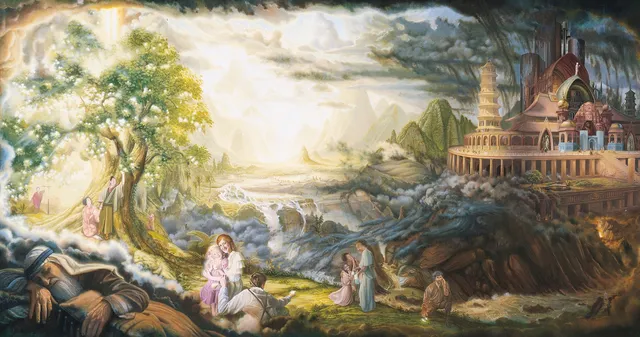
FAIR is a non-profit organization dedicated to providing well-documented answers to criticisms of the doctrine, practice, and history of The Church of Jesus Christ of Latter-day Saints.
“Stay by the Tree.”

“Stay by the Tree.”
FAIR Faithful Resources for Come, Follow Me 2024 January 15-21. 1 Nephi 6–10: “Come and Partake of the Fruit”. These trusted sources can help you find answers to difficult questions and help you in your learning and teaching.
Jump to section

The lesson points out that one prominent message in the Book of Mormon is the “great worth” of the word of God. As you consider the many ways Lehi’s family was blessed by the word of God, the following might be enlightening:
Many have questions about Nephi’s final, fatal interaction with Laban. Did Nephi commit “cold blooded murder” when he killed Laban? Could Satan have deceived Nephi into killing Laban? Find answers to these questions and more below.
Israelites from the Northern tribes, including the tribes of Joseph, had fled to Jerusalam in the 8th century BC
It is claimed that the fact that Lehi was not of Judah, but of the tribe of Joseph, makes it absurd for him to have been living in Jerusalem before the Babylonian captivity: “The tribe of Joseph at Jerusalem! Go, study scripture-geography, ye ignorant fellows, before you send out another imposition, and make no more such foolish blunders.”[1]
Research by Jeffery R. Chadwick shows that Israelites from the Northern tribes, including the tribes of Joseph, had fled to Jerusalam in the 8th century BC, and their descendants had become established in that city by the time of King Zedekiah.
The story of 1 Nephi begins in Jerusalem ca. 600 BC, where Lehi had “dwelt…all his days” (1 Nephi 1:4). A curious fact is that all our principal characters (Lehi, Laban, and Ishmael), as descendants of Joseph, are Israelites of the Northern Kingdom (see 1 Nephi 5:14, 16). Nonetheless, they seem to be wealthy and powerful people in Jerusalem. This would, at first, seem to be amiss, and certainly not what you would expect from a 19th century writer telling a story about “Jews at Jerusalem.” Archaeologist Jeffrey R. Chadwick, however, has shown that just a few generations earlier an influx of refugees from the Northern Kingdom poured into Jerusalem in the wake of the Assyrian conquest of 722-721 BC. These refugees had settled into an extension of the city known as the Mishneh, which by the time 1 Nephi begins, had become fairly well-to-do and had been enclosed by the extended city-wall. (See Jeffrey R. Chadwick, “Lehi’s House at Jerusalem and the Land of his Inheritance,” in Glimpses of Lehi’s Jerusalem, 87-99, 118-124.) This thus fits the portrayal in 1 Nephi of powerful and wealthy Northern Kingdom Israelites being present in Jerusalem at that period.
“The name of LMN [i.e., LaMaN, since Semitic languages at this point have no written vowels] is also found among the inscriptions”
Hugh Nibley noted:
The name of LMN [i.e., LaMaN, since Semitic languages at this point have no written vowels] is also found among the inscriptions. Thus in an inscription from Sinai: “Greetings Lamin, son of Abdal.” (Shlm Lminu bn Abdl).33 Recently the name Laman (written definitely with a second “a”) has turned up in south Arabia and been hailed by the discoverers as “a new name.”34 In an inscription reading “Lamai son of Nafiah erected this monument,”35 the final Yod is defective and suggests that the word is really Laman. In Palestine the name of Laman is attributed to an ancient Mukam or sacred place. Most of these Mukams are of unknown date, many of them prehistoric. In Israel only the tribe of Manasseh (Lehi’s tribe) built them.36 The name of Lemuel, as we have seen, also comes from the deserts of the south.[1]
Pendant names
Even more impressive is the issue of pendant names–names that go together, like “Mike and Ike” or “Ken and Barbie”.
Nibley points out:
But the most striking thing about the names of Laman and Lemuel is the way they go together; as we saw above it has been suggested that the former is but a corruption of the latter.37 Whether that is so or not, the musical pair certainly belong together and are a beautiful illustration of the old desert custom of naming the first two sons in a family with rhyming twin names, “a pair of pendant names,” as Spiegel puts it, “like Eldad and Medad, Hillek and Billek, or Jannes and Jambres. The Arabs particularly seem to enjoy putting together such assonant names Yāǵuǵ and Maǵūǵ for Gog and Magog, HārÅ«n and KārÅ«n for Aaron and Korah, HābÄ«l and KābÄ«l for Abel and Cain, ḪillÄ«t and MillÄ«t for the first dwellers in hell.”38 Speigel is here discussing the names Heyya and Abeyya, and might well have included in his parallels the recently discovered romance of Sul and Shummul. Harut and Marut were the first two angels to fall from grace, like Laman and Lemuel, according to Arab tradition of great antiquity. These names never go in threes or fours but only in pairs, designating just the first two sons of a family with no reference to the rest. This “Dioscuric” practice has a ritual significance which has been discussed by Rendel Harris, 39 but of the actual practice itself, especially among the desert people, there can be no doubt, for we read in an ancient inscription: “N. built this tomb for his sons Hatibat and Hamilat.”40 One could not ask for a better illustration of this little-known and, until recently, unsuspected practice than we find in the Book of Mormon where Lehi names his first two sons Laman and Lemuel.[2]
The existence of so many Hebrew and Egyptian names and phrases in the Book of Mormon is strong evidence of its truthfulness. Learn about these discoveries below.
The existence of so many Hebrew and Egyptian names and phrases in the Book of Mormon is strong evidence of its truthfulness. Learn about these discoveries below.

1-6: Nephi describes his purpose for keeping his record, which is to persuade men to draw nearer to God.
1-5: The brothers return to Jerusalem and persuade Ishmael and his family to join them on their journey.
6-15: Laman, Lemuel and some of Ishmael’s family desire to return to Jerusalem. Nephi attempts to convince them to put their faith and trust in God, emphasizing that Jerusalem will soon be destroyed according to Lehi’s prophecy.
16-22: Nephi is bound with cords and his life threatened. The Lord intervenes on Nephi’s behalf. Additionally, the pleadings of some in Ishmael’s family finally turn the hearts of Laman and Lemuel. The entire group return to Lehi and Sariah in the wilderness.
1-38: Lehi’s vision of the tree of life: Lehi is led by an angelic messenger through a dark wilderness. Calling upon God, he beholds the tree of life. The fruit is wonderful beyond words and Lehi bids his family to join him. The vision expands to include the iron rod and the great and spacious building. He witnesses the interaction of multitudes of people with both the tree of life and the great and spacious building.
1-6: Nephi describes the two sets of plates that he is creating: one for the secular history of his family and descendents, and one for their spiritual history.
1-16: Lehi continues to share the visions and revelations he experienced, recounting the scattering of the Jews, their eventual return to Jerusalem and the birth and baptism of the Messiah. However, Nephi’s family and perhaps others will remain scattered, aiding the Gentiles to receive the full gospel.
17-22: Nephi describes the path which led him to also experience visions and spiritual truths, similar to his father. Obtaining the Holy Ghost is key.


Endnotes
1 Tamara W. Runia, “Seeing God’s Family through the Overview Lens,” Liahona, November 2023, ChurchofJesusChrist.org.
2 Wilford Woodruff’s Journal, May 6, 1854, p. 28, The Wilford Woodruff Papers, wilfordwoodruffpapers.org/journal/1854-05-06.
3 Russell M. Nelson, “Think Celestial!”, Liahona, November 2023, ChurchofJesusChrist.org.

Shauna Horne
Shauna graduated from Brigham Young University-Idaho in April 2022 with a Bachelor’s Degree in Marriage and Family. She has spent most of her life raising her four children and two foster daughters. She loves being a mother and now a grandmother to three perfect preschoolers. She has a passion for marriage and family. She worked for Wilford Woodruff Papers as an intern on the content team and was hooked. Now, she is ecstatic to accept a position as the content manager. She loves the gospel and is thrilled to be a part of a project that will impact generations to come. Besides the gospel, Shauna loves hiking in the Pacific Northwest where she lives, reading, going on adventures with her husband and children, camping, and anything water related. She also has been an early morning seminary teacher the last seven years and loves teenagers.

Lesson devotionals are provided by the Wilford Woodruff Papers Foundation. Its mission is to digitally preserve and publish Wilford Woodruff’s eyewitness account of the Restoration of the gospel of Jesus Christ from 1833 to 1898. It seeks to make Wilford Woodruff’s records universally accessible to inspire all people, especially the rising generation, to study and to increase their faith in Jesus Christ. See wilfordwoodruffpapers.org.

FAIR is a non-profit organization dedicated to providing well-documented answers to criticisms of the doctrine, practice, and history of The Church of Jesus Christ of Latter-day Saints.
We are a volunteer organization. We invite you to give back.
Donate Now